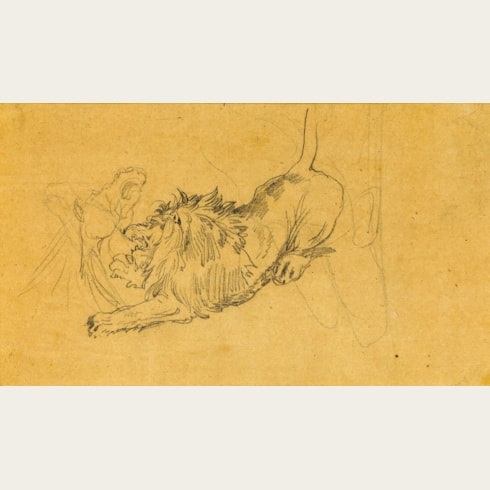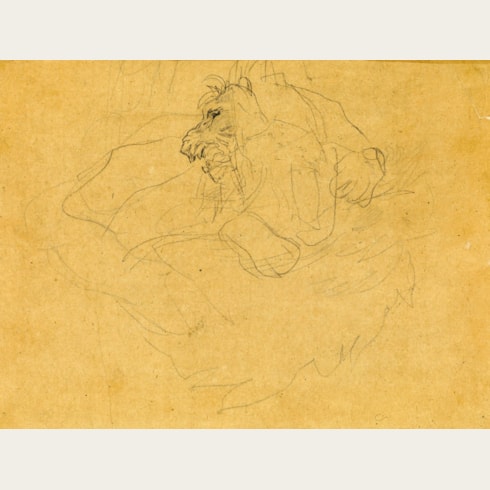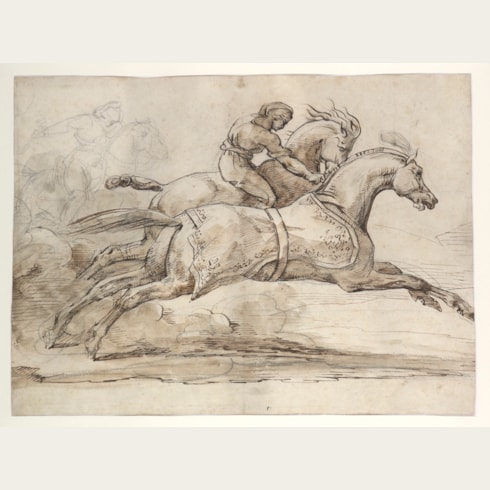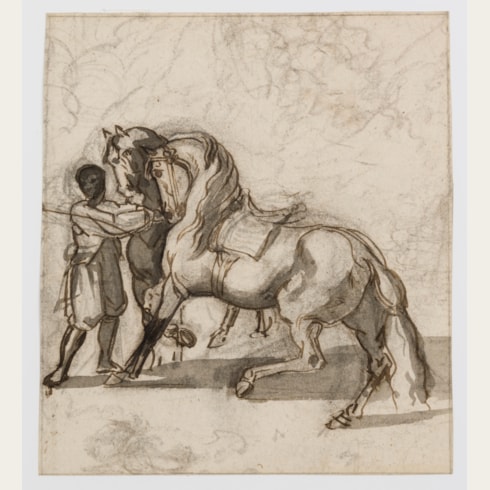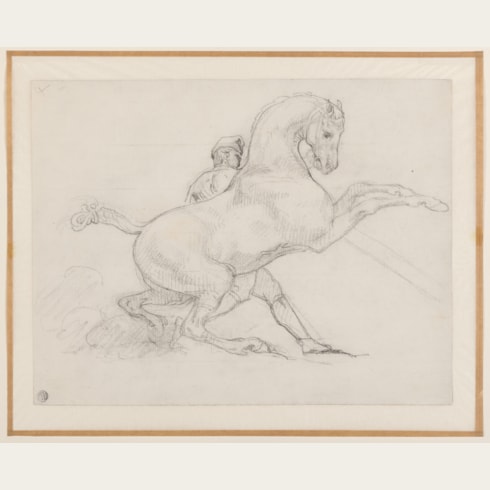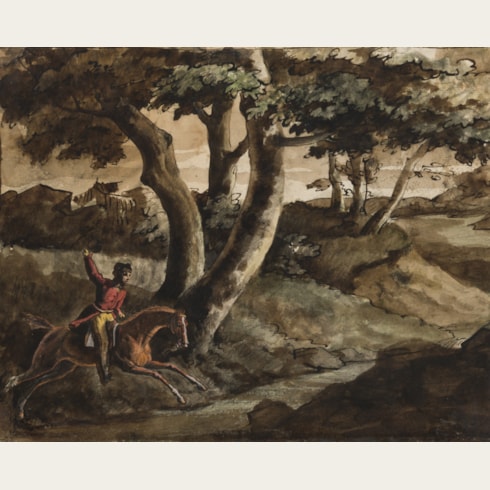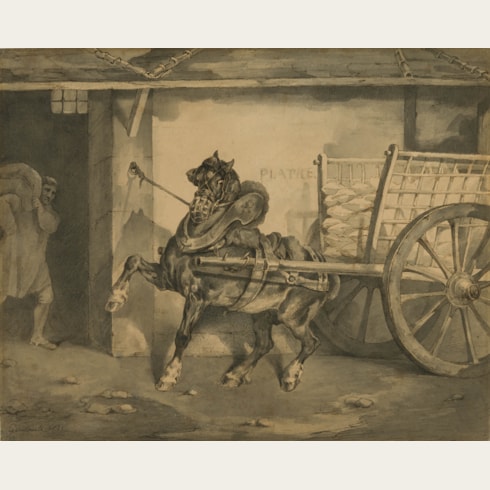Théodore GERICAULT
(Rouen 1791 - Paris 1824)
Four Men Restraining a Wild Horse
226 x 321 mm. (8 7/8 x 12 5/8 in.)
Géricault worked on a series of drawings and oil sketches on paper on the theme of the Race of the Barberi Horses for most of his time in Italy - a period of some seven months in all - culminating in a huge canvas, which measured some thirty feet in length. On his sudden return to France in September 1817, however, the painting was abandoned unfinished in his Roman studio, and no longer survives. Nevertheless, some idea of the genesis and development of the composition can be had from the approximately twenty oil sketches and sixty drawings related to the project which the artist brought back with him when he returned to Paris. As Charles Clément, Géricault’s early biographer and author of the first catalogue raisonné of his work, has noted, ‘The admirable drawings of the Race of the Riderless Horses which have survived are executed, in pen and ink for the most part, with details indicated very lightly with a few hatchings. One would be very wrong to regard these as improvisations, or mere sketches.’
The present sheet depicts four grooms straining to control a horse before the start of the race; two at the head of the animal and two more at the tail, one of whom is only visible by his cap. (The motif of a groom pulling on the horse’s tail is one that appears in several of the artist’s studies for the Race of the Barberi Horses.) Writing some thirty years before Géricault’s visit to Rome, Johann Wolfgang von Goethe attended the corso de’ Barberi and described the scene at the start of the race: ‘Most of [the horses] are already frisky and impatient; the presence of so many people makes them nervous, and the grooms need all their strength and skill to manage them. They kick against the partition or try to jump over the rope, and all this commotion increases the excitement of the onlookers. The grooms, too, are overexcited, because, in deciding the outcome of the race, much depends upon the skill with which the horse is released at the start.’
This figural group of four grooms restraining a rearing horse is the finest of several related versions of the same composition. In his 1879 catalogue of Géricault’s work, Clément listed four different drawn variants of this group. A smaller and more schematic drawing of this composition, likely to be a copy of the present sheet, was in a French private collection in the 1950s, while another smaller version, drawn in black chalk alone, was in a private collection in Paris and recently appeared at auction there. A lithograph by Alexandre Colin reproduces both the present study and another drawing by Géricault, of two men killing a bull, on the same sheet, while a tracing of this subject by Colin, in reverse, is also known. A small sketch of this figural group appears on a double-sided landscape drawing by Gericault in the Museum Boijmans-van Beuningen Museum in Rotterdam.
As Wheelock Whitney has written of this particular composition, ‘It is unclear why Géricault drew so many versions of this image, which does not appear in any of the subsequent stages of the Race project…He may have considered making a small painting of this isolated group, for which all these drawings would have served as studies…Whatever his original intentions for this image, however, Géricault made partial use of it in various other Race studies as the project progressed…in a manner wholly typical of his resourceful and complex working method on the Race project, Géricault took elements from this drawing, altered them to a greater or lesser extent and inserted them in later, otherwise unrelated compositional studies, where they are barely recognizable in their new form.’
The bold handling of pen and ink, applied with a reed pen, in this drawing is a characteristic of Géricault’s draughtsmanship both before and during his year in Italy. As Whitney has noted of the drawings brought back by Géricault from Rome, ‘One of the chief benefits of the Italian year was the maturation it brought about in Géricault’s style. The most notable evidence of this advance is the more fluid and confident graphic manner he developed in Italy, in no small part due to his lengthy and complex preparatory process for the Race of the Barberi Horses. The fact is rarely acknowledged, but Géricault was, with Ingres, one of the two greatest draughtsmen of the first half of the nineteenth century. His drawings, whether preliminary studies for ambitious works such as the Race, mere exercises in graphic dexterity or elaborate, finished compositions intended from the outset as finished works of art, fairly vibrate with energy and expressiveness…The drawings done in Italy, where Géricault’s graphic style reached its maturity, are marked by an unprecedented freedom of handling and a palpable assurance of touch that he maintained, even as his style evolved, for the rest of his brief career.’
The first known owner of this drawing was the 19th century art historian Marie-Joseph-François Mahérault (1795-1879). The drawing was then acquired, probably at the posthumous sale of Mahérault’s collection in 1880, by the prominent Alsacian industrialist and collector Jean Dollfus (1823-1911), who owned numerous paintings and drawings by Camille Corot, Gustave Courbet, Honoré Daumier, Eugène Delacroix, Théodore Rousseau, Auguste Renoir, Alfred Sisley and many others.
The present sheet then entered the exceptional collection of paintings and drawings by Géricault assembled by the artist and scholar Pierre Olivier Dubaut (1886-1968). As an artist, Dubaut produced paintings, watercolours and prints of horses and equestrian subjects. He was especially fond of the work of Géricault, and organized several important exhibitions of his work. He had planned to publish a catalogue of the artist’s work, in collaboration with the Duc de Trévise, but this never came to fruition. Dubaut also owned works by Delacroix, Richard Parkes Bonington and Jacques-Louis David, among others.
Provenance
His posthumous sale, Paris, Hôtel Drouot, 27-29 May 1880, part of lot 74 (Cinquante calques et quelques croquis pour ses compositions les plus importantes telles que: Le Naufrage de la Méduse, les Courses de taureaux, les Barbieris, le Maréchal ferrant, le Marchand d’esclaves, Lion attaquant un cheval, figures académiques, épisodes des guerres de l’Empire, Mazeppa, voiture de soldats blesses, etc.)
Jean Dollfus, Paris
His posthumous sale, Paris, Hôtel Drouot, 4 March 1912, part of lot 54 (La Course des Barberi à Rome)
Pierre Olivier Dubaut, Paris (Lugt 2103b), by 1934
M. Marillier, by 1937
Anonymous sale, New York, Christie’s, 22 January 2003, lot 102
Gérard Lhéritier (Aristophil), Nice.
Literature
Exhibition







